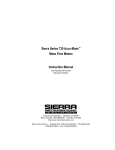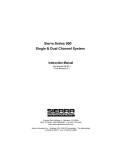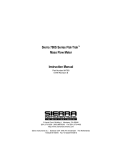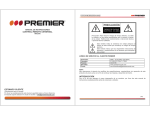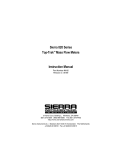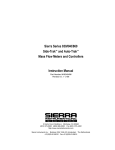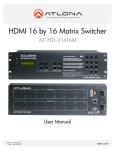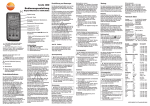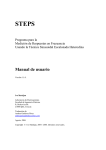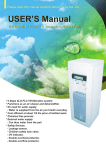Download Sierra Video 10 Series Instruction manual
Transcript
Sierra Series 1610 Flo-Multimeter™ Portable Air Velocity Meter March 1991 REV. B Part Number: IM-61 5 Harris Court, Building L · Monterey, CA 93940 (408) 373-0200 · (800) 866-0200 · Fax (408) 373-4402 SIERRA INSTRUMENTS b.v. · Bolstoen 30A · 1046 AV Amsterdam · The Netherlands 31(0)20-6145810 · Fax 31(0)20-6145815 1610 Flo-Multimeter Instruction Manual CUSTOMER CAUTION RE: OXYGEN SERVICE Sierra Instruments, Inc., is not liable for any damage or personal injury, whatsoever, resulting from the use of Sierra Instruments mass flow meters or controllers for oxygen gas. Although Sierra cleans its mass flow meters and controllers prior to shipment, we make no claim or warranty that their cleanliness renders them safe for oxygen service. The customer must clean Sierra Instruments mass flow meters or controllers to the degree required for the customer’s oxygen flow applications. © COPYRIGHT SIERRA INSTRUMENTS 1994 No part of this publication may be copied or distributed, transmitted, transcribed, stored in a retrieval system, or translated into any human or computer language, in any form or by any means, electronic, mechanical, manual, or otherwise, or disclosed to third parties without the express written permission of Sierra Instruments. The information contained in this manual is subject to change without notice. TRADEMARKS Accu-FloTM and Flo-MultimeterTM are trademarks of Sierra Instruments Inc. Page 19 1610 Flo-Multimeter Instruction Manual 1 Introduction ........................................................................... 1 2 Description ............................................................................. 2 3 Principle of Operation ........................................................... 3 4 Specifications ......................................................................... 4 5 Preparation For Use of Your Flo-MultimeterTM. .................. 6 6 5.1 Cleaning the Probe ....................................................... 6 5.2 Using the Probe ............................................................. 6 5.3 Probe Storage ................................................................ 6 Operating Instructions .......................................................... 7 6.1 Measuring Air Velocity ................................................. 7 6.2 Measuring Temperature ............................................... 7 6.3 Measuring Static Pressure ........................................... 8 7 Calculating Actual Velocity ................................................... 9 8 Calibration ........................................................................... 10 8.1 9 TABLE OF CONTENTS Calibration At Sierra Instruments, Inc. ................... 10 Maintenance ......................................................................... 11 9.1 Breakage or Damage of Accu-FloTM Probe ................ 11 9.2 Ni-Cad Battery Maintenance ..................................... 11 10 Troubleshooting .............................................................. 12-13 Important Note: ......................................................................... 14 Appendices A Exploded View of Flo-Multimeter .................................. 15-16 B Schematic ............................................................................. 17 Page 18 1610 Flo-Multimeter Instruction Manual This instruction manual applies to the following Sierra Instruments, Inc., Series 1610 Flo-MultimeterTM Portable Air Velocity Meters: Model No. Range 1610 1619 1618 1617 1616 1615 1615HT 1615M 1615MHT 1619M 1617M 1616M 0-300, 0-1250, 0-2500 fpm; 0-3 in. water 0-300, 0-1250, 0-6000 fpm; 0-5 in. water 0-100, 0-300, 0-1250, 0-6000 fpm 0-300, 0-2500, 0-12000 fpm; 0-5 in. water 0-300, 0-6000 fpm; –40 to 250°F; 0-5 in. water 0-300, 0-1250, 0-6000 fpm, –40 to 250°F 0-300, 0-1250, 0-6000 fpm; 0-500°F 0-1.5, 0-6, 0-30 m/s; –40 to 125°C 0-1.5, 0-6, 0-30 m/s; 0 to 250°C 0-1.5, 0-6; 0-30 m/s; 0-120 mm water 0-1.5, 0-10, 0-60 m/s; 0-120 mm water 0-1.5, 0-30 m/s; –40 to 125°C, 0-120 mm water 1 INTRODUCTION Each Flo-MultimeterTM comes complete with Accu-FloTM probe, cable, meter, and static pressure attachment (where applicable), all in a rugged carrying case. (Add Suffix to Model No.) HT High Temperature Operation to 500°F (250°C) L24 24 in. Long Accu-FloTM Probe L36 36 in. Long Accu-FloTM Probe CP-( ) Special Cable Length up to 50 feet; indicate length (ft.) in parentheses CPT-( ) Special “HT” Cable Length up to 50 feet; indicate length (ft.) in parentheses Options Page 1 1610 Flo-Multimeter Instruction Manual Sierra’s Series 1610 Flo-MultimeterTM is a lightweight, portable and versatile instrument for measuring air velocity, temperature, and air static pressure. The meter and probe weigh less than 3 pounds (1.3 kg). Applications include monitoring of hood velocity, clean rooms, OSHA compliance, ventilation ducts and outlets, heating and air-conditioning, wind tunnels, product development, air-flow research, mass-flow measurement in ducts, and high temperature measurements in stacks and hot gas flows. 2 DESCRIPTION Your Flo-MultimeterTM is a rugged, portable instrument intended for the rigors of field use. The meter, probe and cable, battery charger and pressure attachment (where applicable) are all enclosed in the handy carrying case for transporting to the field. The meter has a durable taut-band movement. The large sensor is the most rugged of its kind and is resistant to dirt, contamination, and breakage. It is easily cleaned by using water or alcohol and a small artist’s brush. The probe is conveniently stored in the body of the meter. To remove the probe, simply press down on the side cover to expose the end of the probe and cable, and remove the probe. Your Flo-MultimeterTM may also have an extra-long probe or cable length as indicated by the suffix to the model number. Probes longer than 13 inches with standard cable include a 101⁄2 inches long probe extender/shield. HT models can be operated in stacks or hot gas flows up to 500°F, (250°C). This maximum temperature should not be exceeded. Since the sensor is glass coated, stacks with hydrofluoric acid should be avoided. Page 2 1610 Flo-Multimeter Instruction Manual Sierra’s Accu-FloTM air velocity probe has two sensors, a velocity sensor and a temperature sensor (see Figure 1). The velocity sensor is a self-heated platinum resistance temperature detector (RTD). The temperature sensor compensates for changes in ambient temperature. The bridge circuit continuously maintains the velocity sensor at a constant temperature differential above ambient. The electronics measure the cooling effect of the air as it passes over the velocity probe. 3 PRINCIPLE OF OPERATION Since the heat is carried away by the molecules in the air, the sensor measures air mass velocity, referenced to “standard” conditions ofˇ70°F and 760 mm of mercury. For most applications, standard velocity is the desired quantity. For “actual” velocity, the standard velocity is simply multiplied by the air density relation as described in Section 8, CALIBRATION. Figure 1 shows the principle of operation. The voltage/velocity curve is a non-linear function, with everincreasing sensitivity as velocity decreases. This non-linear response is a major advantage because it provides a tremendous rangeability of 2000:1 with one meter (5 to 12,000 fpm) as well as excellent low-speed sensitivity. Both the velocity and temperature sensors are rugged, glass coated platinum RTD’s. The unexcelled stability and reproducibility of RTD’s have made them the standard of NIST. The velocity sensor is rugged and large, not a fragile hot wire. It is breakage resistant, insensitive to dirt, and easily cleaned using an artist’s brush with water or alcohol. NOTE: Your Flo-Multimeter probe was calibrated in the horizontal position. To obtain maximum accuracy at velocities of less than 300 SFPM, the probe must be oriented in the same position as it was during calibration. Figure 1 Operating Principle AIR VELOCITY SENSOR 0.032 DIA. TEMPERATURE SENSOR 0.125 DIA. AIR VELOCITY 0.25 DIA. .125 .125 .938 Page 3 1610 Flo-Multimeter Instruction Manual Velocity Accuracy: ± 2% of full scale over –20 to 60°C and 5 to 30 psia; ± 4% of full scale over –55 to –20°C and 60 to 125°C; ± 4% of full scale over 1 to 5 psia and 30 to 100 psia; ± 4% of full scale for “HT” models over 100 to 250°C 4 SPECIFICATIONS Temperature Accuracy: ± 1% of full scale over 20-40°C Pressure Accuracy: ± 2% of full scale over 20-40°C Repeatability: ± 0.2% of full scale for velocity and temperature Response Time: Probe: 100 msec; meter readout: 500 msec Probe Temperature: –40 to 125°C standard; 0 to 250°C “HT” models Front Panel: Range selection and battery test switch; mechanical zero; zero and span controls inside meter Readout: 12 cm, taut-band analog meter; self-shielding; 0-50°C operating range; –20 to 70°C storage range Probe: Ceramic, platinum, and epoxy sensor, glass-coated; 316 self-stowing stainless steel probe; 1/4 inch diameter probe, 8 inches long with coiled cable; markings every inch along axis; optional probe lengths of 13, 24, 26, and 48 inches are available; however, they are not self-stowing. Probe Cable: Four wire; 6 foot length (coiled); additional (non-coiled) lengths optional Power Required: Ni-Cad rechargeable batteries; charger operates on 115/230 VAC, 50/60 Hz power; operates up to 8 hours between charges at 1250 fpm, 6 hours at 6000 fpm, and 5 hours at 12,000 fpm. See Figure 2. Net Weight of Meter and Probe: 2.75 lb/1.25 Kg Page 4 1610 Flo-Multimeter Instruction Manual Figure 2 Operating Time for Batteries 10000 8000 6000 4000 2000 12 hours at 0 fpm 0 4.5 5 6 7 8 9 Page 5 1610 Flo-Multimeter Instruction Manual Inspect the air velocity sensor (the sensor with the small 0.032 inch diameter). If it is visibly dirty, clean it with water or alcohol (ethanol) and an artist’s brush until it appears clean again. Even though the sensor is rugged and breakage-resistant, avoid touching it with any solid object and use a light touch in cleaning it. The Accu-FloTM probe is insensitive to small amounts of contamination or dirt, so a little contamination or discoloration will not cause accuracy errors. The temperature sensor is generally insensitive to contamination and dirt. 5 PREPARATION FOR USE OF YOUR FLO-MULTIMETERTM For most measurements in open air (external flows), the 8 inch long probe is of sufficient length. For applications routinely requiring longer probe lengths, Accu-FloTM probes with extended length of 13, 24, and 36 inches are available from Sierra. These longer probes will not stow in the meter, but are shipped with a 101⁄2 inch long probe extender/shield and standard non-coiled cable. 5.2 Using the Probe 5.1 Cleaning the Probe For measurements in ducts, pipes, or other internal flows, use a 1/4 inch compression tube fitting x 1/4 inch NPT, or other suitable bulkhead fitting, inserted over the probe and screwed into the duct. Nylon or Teflon ferrules are desirable so that the probe can be traversed easily over the cross section of the duct to get the total mass flow rate. The circumferential scribe marks on the probe, 1 inch apart, aid in traversing. After traversing, the probe can be permanently located at the average velocity point in the duct, and the compression fitting tightened. Figure 3 shows the best velocity measurement points in circular and rectangular ducts or stacks. Figure 3 Optimum Measurements in Ducts or Stacks b R b/4 0.7R a/4 a The standard Model 1610 has an 8 inch probe and a 6 foot coiled cable. Both the probe and cable are conveniently stored in the body of the meter. A sliding plate covers the probe storage area. To obtain access to the probe, simply push down on the slide cover to expose the end of the probe and remove. 5.3 Probe Storage When the meter is purchased with longer length probe, the probe cable plugs into a connector. This connector is located behind the sliding cover. Page 6 1610 Flo-Multimeter Instruction Manual Operation of the Series 1610 is straightforward. All controls on the front panel are clearly designated as to their function. 1. Turn main switch to “Battery Test” to check the condition of batteries. Recharge if necessary. (The batteries must be tested with the probe connected). 2. See Section 5, PREPARATION FOR USE OF YOUR FLO-MULTIMETER™ for a discussion of probe lengths. Figure 3 gives the recommended velocity measurement points in ducts and stacks. 6 OPERATING INSTRUCTIONS 6.1 Measuring Air Velocity 3. Insert the probe into the flow so that the flow field covers the entire tip of the probe at least 11⁄4 inches, and preferably 2 inches, from the end. Rotate the probe so that the flow is perpendicular to the flow “window”. The axial line scribed on the probe should point upstream and line up with the flow. The Accu-FloTM probe measures air speed accurately when the velocity vector is anywhere within a solid cone with a 20 degree half angle, relative to the normal, to the velocity probe. 4. Rotate the main switch to the highest (first) air velocity scale. Then, continue to rotate the switch to the lowest range covering the maximum velocity anticipated. The FloMultimeterTM is now measuring air velocity. If “actual” velocity is desired, use the procedure in Section 8, CALIBRATION. For gases other than air consult the factory. Allow approximately three minutes for temperature equilibrium. 5. If long term measurements of several hours are being made, check Figure 2 for the expected battery life before recharging as necessary. NOTE: Your Flo-Multimeter probe was calibrated in the horizontal position. To obtain maximum accuracy at velocities of less than 300 SFPM, the probe must be oriented in the same position as it was during calibration. 1. Turn the main switch to “Battery Test” to check the condition of batteries. Recharge if necessary. (The batteries must be tested with the probe connected). 6.2 Measuring Temperature 2. See Section 5, PREPARATION FOR USE OF YOUR FLO-MULTIMETER™ for a discussion of probe lengths. 3. Insert the probe into the flow so that the flow field or gas covers the 1⁄8 inch diameter temperature sensor. It is desirable that the entire tip of the probe is “wetted” at least 11⁄4 inch or, preferably, 2 inch, from the end. Although the Flo-MultimeterTM is designed for temperature measurement in air and gases, it can also be used in non-corrosive liquids, such as water, over the specified temperature range. Page 7 1610 Flo-Multimeter Instruction Manual 4. Rotate the main switch to the temperature scale. The FloMultimeterTM is now measuring temperature. 5. When switching from a velocity scale or battery check to the temperature scale, about 60 seconds are required for the temperature sensor to attain the correct reading. 6. Since the temperature measurement mode requires minimal electrical current, the batteries should last a long time between charging. Nevertheless, it is prudent to make a periodic check on “Battery Test”. 1. Rotate the main switch to “Battery Test” to check the condition of the batteries. Recharge if necessary. (The batteries must be tested with the probe connected). 6.3 Measuring Static Pressure 2. Meters with an air static pressure scale have a static pressure attachment in the carrying case. The attachment is a 1⁄4 inch diameter x 2 inches long anodized aluminum fixture with gasketed inlet and outlet flanges. Insert the pressure attachment over the tip of the probe until it bottoms out. Rotate until the radial scribe line on the bottom of the attachment is oriented with the axial scribe line on the probe, and tighten the nylon thumb screw. 3. Drill a 0.25 to 0.31 inches diameter hole in the duct or pipe. Static pressure can only be made in ducts with low positive or negative static pressures relative to ambient 0-3 or 0-5 inches of water, maximum. Do not use in high pressure installations. 4. Place the flange over the duct hole and hold firmly in place with the probe parallel to the duct wall, so that the gasket effects a good seal. If the pressure in the duct is positive (+), or higher than ambient, the flange with the “+” sign should be placed over the hole. If the pressure in the duct is negative (–), the flange with the “–” sign should be placed over the hole. The Accu-FloTM probe measures the static pressure differential between the duct and ambient by measuring the flow through the orifice in the pressure attachment. For this reason, the static pressure scale is calibrated for air static pressure. With the proper “+” and “–” orientation given above, the flow always impinges the velocity sensor one way. The FloMultimeterTM is now measuring air static pressure. 5. If long-term measurements of several hours are being made, periodically check the batteries on “Battery Test”. (The batteries must be tested with the probe connected). Page 8 1610 Flo-Multimeter Instruction Manual As discussed in Section 3, PRINCIPLE OF OPERATION, the AccuFloTM probe measures the “standard” velocity or the mass velocity of air referenced to 70°F and 760 mm of mercury. The units of measurement are standard feet per minute (SFPM) or standard meters per second (SMPS). Since they directly measure mass velocity, Flo-MultimeterTM is ideal for measurement of air mass flow in ducts or in external flows. In these cases no correction is needed. In cases where the “actual” velocity of the air at the actual temperature and pressure at the time of measurement is desired, a single correction is required. In this case, the velocity is in units of feet per minute (fpm) or meters per second (m/s). The required correction factor is given in the following equation: V = Vs ( ρs/ρ) = Vs ( Ps/P) (T/Ts) 7 CALCULATING ACTUAL VELOCITY (1) where: V = Vs = ρ = ρs = T = Ts = P= Ps = “actual" velocity at conditions of ρ, P, and T; “standard” velocity referenced to standard conditions of ρs, Ps, and Ts; air mass density at actual conditions, g/cc; air mass density at standard conditions, = 1.189 x 10-3 g/cc; air temperature at actual condition, (°R); standard air temperature = 70°F = 529.7; air pressure at actual conditions, mm of mercury; and standard air pressure = 760 mm of mercury. Example: The Model 1615 Flo-MultimeterTM shows a reading of 1000 SFPM on the 0-1250 fpm scale. The air temperature, as measured on the –40 to 250°F temperature scale, is 120°F. The flow field is open to the atmosphere and the barometric pressure is 800 mm mercury. From Equation (1), the actual velocity V is calculated as: V = 1000(760/800) ([120 + 459.7]/729.7) = 1039.7 FPM Page 9 1610 Flo-Multimeter Instruction Manual To ensure the continuing high accuracy of your Flow-Multimeter™, Sierra Instruments, Inc., maintains a fully-equipped, quality-controlled Flow Calibration Metrology Laboratory for recalibration of all meter scales. If the probe or meter have been damaged, or you simply want to recalibrate, please call Sierra’s Customer Service Department for a prompt and attentive response to your request. 8 CALIBRATION 8.1 Calibration at Sierra Instruments, Inc. Having Sierra Instruments do your calibration will prove to be the most cost-effective alternative. Follow Section 9.2, NI-CAD BATTERY MAINTENANCE, if you wish to do your own calibraiton. Page 10 1610 Flo-Multimeter Instruction Manual If the sensors of the Accu-Flo™ probe are broken or damaged, the probe, meter, and pressure attachment must be returned to the factory. A new probe will be installed and recalibrated with your meter. Since the zero and span for each meter scale is set up on the circuits inside the meter, the probe, meter, and pressure attachment must accompany the probe in shipment back to the factory. Call Sierra’s Customer Service Department for further information. With reasonable care, Ni-Cad batteries will give you many dependable hours of use. By following these maintenance procedures you will prolong their service. 9 MAINTENANCE 9.1 Breakage or Damage of Accu-Flo™ Probe 9.2 Ni-Cad Battery Maintenance 1. Be sure to set the “115-230 VAC” switch on the charger for the proper line voltage. 2. “Sustained Overcharging Heat”: This is caused by overheating the batteries to a point where they become hot and slowly begin to destroy cell chemistry. Avoid overcharging! 3. “Cell Reversal”: This condition takes place when one of the cells in the battery “strip” is completely discharged. The remaining cells then force a current through the discharged cell causing it to reverse, destroying cell chemistry. Avoid this by keeping an eye on the “BATT OK” range and noting if discharging proceeds at a rapid rate. 4. “Memory”: “Memory” is a condition resulting from consistently discharging the battery pack to a small percentage of its full capacity and then being recharged. “Memory” can be reversed with a series of full charge/discharge cycles. The battery pack will normally improve with each cycle. It is a good idea to periodically run the battery pack down and then recharge fully before your next scheduled reuse. If your Flo-Multimeter™ will not operate in the “BATT OK” range, and the batteries are found to be at fault, order a new Model No. 1610002 Ni-Cad Battery Pack from Sierra Instruments, Inc. To install, remove the back cover, un-solder the leads to the two old batteries, and solder in the new batteries. Typical battery charge time should not exceed 14 to 15 hours with the main switch in the off position. Page 11 1610 Flo-Multimeter Instruction Manual 10 TROUBLESHOOTING PROBLEM POSSIBLE CAUSE ACTION Velocity or pressure measurement seems low A. Probe not oriented properly A. Orient probe with respect to flow B. Batteries low B. Recharge C. Probe dirty C. Clean probe with water or ethanol and a small artist’s brush A. Very turbulent flow A. Try to find less turbulent area to measure velocity B. Probe tip is broken B. Return probe and meter to factory for repair or replacement of probe and recalibration C. U1 (integrated circuit No. 1) defective C. Replace with same type IC (available from Sierra) or return to factory D. Probe is not secured to a solid base D. Secure probe to a non-vibrating solid mount A. Probe not plugged into meter A. Plug in probe B. Probe tip is broken B. Return probe and meter to factory for repair or replacement of probe and recalibration C. U2 (integrated circuit No. 1) defective C. Replace with same type IC (available from Sierra) or return to factory D. Q1 (transistor No. 1) shorted D. Replace with same type transistor (available from Sierra) or return to factory Velocity or pressure measurement is erratic Meter needle pegs Table 10.0 Troubleshooting Page 12 1610 Flo-Multimeter Instruction Manual PROBLEM POSSIBLE CAUSE ACTION Batteries won’t charge (“Batt. OK” indicates low) A. Battery charger defective A. To determine if battery charger is operating, switch meter to “battery test” position and note needle position with charger unplugged. Needle should rise slightly when charger is plugged in, indicating batteries are charging. If a DVM is available, charger output at plug tip should be 7.5 VDC with 200 mA current. If not, replace with a 115 or 230 VAC power pack with same voltage current rating. B. Battery charger switch is set to wrong line voltage B. Move switch to correct voltage range C. Batteries defective (not charging or not holding charge) C. Replace with new Model No. 1610002 Ni-Cad Battery Pack A. Mechanical zero off A. Adjust mechanical zero, with power off B. Out of calibration B. Return probe and meter to factory for calibration C. Probe tip is broken C. Return probe and meter to factory for repair or replacement of probe and calibration A. Improper operation for temperature measurement A. Review instruction manual for temperature measurement B. U1 defective B. Replace with same type IC (available from Sierra) or return to factory C. Out of calibration C. Return probe and meter to factory for calibration Meter needle won’t zero Temperature scale no longer accurate Page 13 1610 Flo-Multimeter Instruction Manual The Series 1610 Accu-FloTM probes are individually matched to each meter. Do not interchange probes from one meter to another, or accuracy will suffer greatly. The serial number of each meter is scribed on each probe near the cable end. Important Note SHIPPING NOTE: Ship all meters via UPS to the following address: SIERRA INSTRUMENTS, INC. 5 Harris Court, Building L Monterey, CA 93940 ATTN: SERVICE DEPARTMENT Be sure to include complete return shipping instructions. We cannot deliver to post office boxes. Page 14 1610 Flo-Multimeter Instruction Manual APPENDIX A Exploded View of Flo-Multimeter Item # 1 2 4 5 7 8 9 11 12 13 14 15 16 17 Description Bottom Enclosure Sliding Door Probe Entrance Plate Meter Movement Enclosure Scale Cover Knob Anchor Knob Bushing Top Enclosure Set Screw Strap Boss Strap, 8-1/2"-BRNNew 610 PCB-FABPan Hd Phil Scr Knurled Knob Part No. 6102-057 6102-058 6102-059 6102-061 6102-078 6102-028 6102-029 6102-056 6302-027 6103-012 6102-030 Page 15 1610 Flo-Multimeter Instruction Manual Item # 19 20 21 22 23 25 27 28 29 30 32 A B C Description Pan Hd Phil Scr Zero Adjust Meter Movement Pan Hd Phil Scr Kep Nut Internal Tube Support Batteries Pan Hd. Phil. Scr. Feet, Rubber Meter Bail Needle Scale Label Assembly Cable Assembly Label Assembly Part No. 6102-060 6302-011 6102-077 6102-027 Page 16 1610 Flo-Multimeter Instruction Manual APPENDIX B Schematic Page 17




















